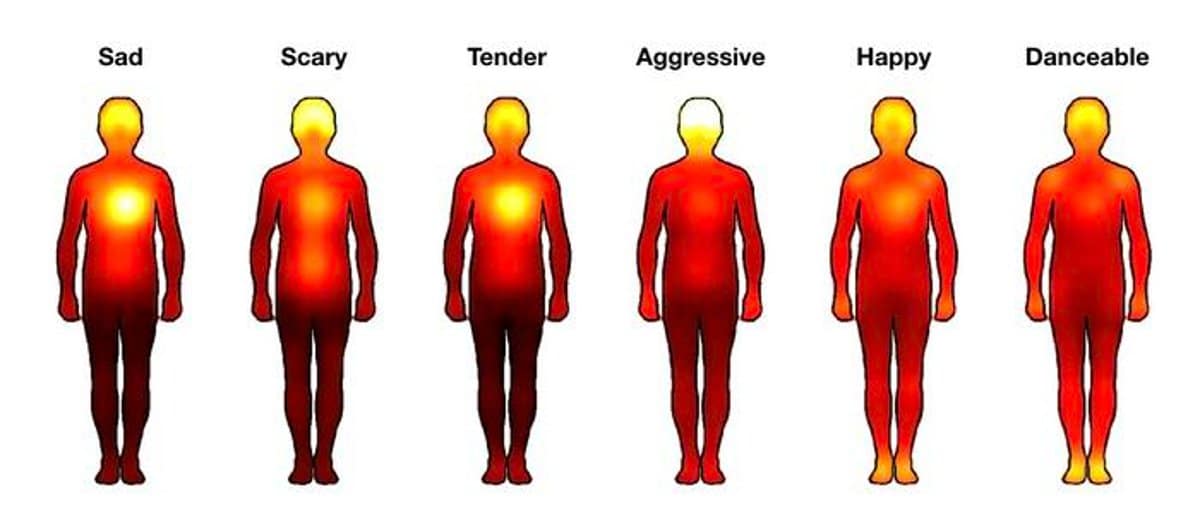Summary: A recent study reveals that music’s emotional impact transcends cultures, evoking similar bodily sensations globally. Researchers found that happy music energizes arms and legs, while sad tunes resonate in the chest.
This cross-cultural study, involving 1,500 participants from the West and Asia, links music’s acoustic features to consistent emotions and bodily responses.
The findings suggest that music’s power to unify emotions and movements may have played a role in human evolution, fostering social bonds and community.
Key Facts:
- Emotional music evokes similar sensations across Western and Asian cultures, with happy music affecting limbs and sad music the chest area.
- The study, involving 1,500 participants, found that music’s influence is likely rooted in biological mechanisms, transcending cultural learning.
- Music’s ability to synchronize emotions and physical responses across listeners may have evolved to enhance social interaction and community.
Source: University of Turku
Music can be felt directly in the body. When we hear our favourite catchy song, we are overcome with the urge to move to the music. Music can activate our autonomic nervous system and even cause shivers down the spine.
A new study from the Turku PET Centre in Finland shows how emotional music evokes similar bodily sensations across cultures.
“Music that evoked different emotions, such as happiness, sadness or fear, caused different bodily sensations in our study. For example, happy and danceable music was felt in the arms and legs, while tender and sad music was felt in the chest area,” explains Academy Research Fellow Vesa Putkinen.

The emotions and bodily sensations evoked by music were similar across Western and Asian listeners. The bodily sensations were also linked with the music-induced emotions.
“Certain acoustic features of music were associated with similar emotions in both Western and Asian listeners. Music with a clear beat was found happy and danceable while dissonance in music was associated with aggressiveness.
“Since these sensations are similar across different cultures, music-induced emotions are likely independent of culture and learning and based on inherited biological mechanisms,” says Professor Lauri Nummenmaa.
“Music’s influence on the body is universal. People move to music in all cultures and synchronized postures, movements and vocalizations are a universal sign for affiliation.
“Music may have emerged during the evolution of human species to promote social interaction and sense of community by synchronising the bodies and emotions of the listeners,” continues Putkinen.
The study was conducted in collaboration with Aalto University from Finland and the University of Electronic Science and Technology of China (UESTC) as an online questionnaire survey. Altogether 1,500 Western and Asian participants rated the emotions and bodily sensations evoked by Western and Asian songs.
Funding: The study was funded by the Research Council of Finland.
About this music and emotion research news
Author: Tuomas Koivula
Source: University of Turku
Contact: Tuomas Koivula – University of Turku
Image: The top image is credited to Neuroscience News. The image in the article is credited to Lauri Nummenmaa, University of Turku
Original Research: Open access.
“Bodily maps of musical sensations across cultures” by Lauri Nummenmaa et al. PNAS
Abstract
Bodily maps of musical sensations across cultures
Emotions, bodily sensations and movement are integral parts of musical experiences. Yet, it remains unknown i) whether emotional connotations and structural features of music elicit discrete bodily sensations and ii) whether these sensations are culturally consistent.
We addressed these questions in a cross-cultural study with Western (European and North American, n = 903) and East Asian (Chinese, n = 1035). We precented participants with silhouettes of human bodies and asked them to indicate the bodily regions whose activity they felt changing while listening to Western and Asian musical pieces with varying emotional and acoustic qualities.
The resulting bodily sensation maps (BSMs) varied as a function of the emotional qualities of the songs, particularly in the limb, chest, and head regions. Music-induced emotions and corresponding BSMs were replicable across Western and East Asian subjects.
The BSMs clustered similarly across cultures, and cluster structures were similar for BSMs and self-reports of emotional experience. The acoustic and structural features of music were consistently associated with the emotion ratings and music-induced bodily sensations across cultures.
These results highlight the importance of subjective bodily experience in music-induced emotions and demonstrate consistent associations between musical features, music-induced emotions, and bodily sensations across distant cultures.







